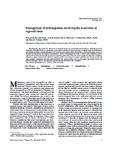|
|
Creator | Title | Description | Subject | Date |
| 301 |
 |
Couldwell, William T. | Giant pituitary tumor combined approach | Nishioka et al. have provided a review of 29 patients with large pituitary adenomas who underwent surgery through a simultaneous transsphenoidal and transcranial approach at their institution during a 7-year period. Large adenomas with hourglass constriction, complex lobulations, and asymmetric exte... | | 2012-01-01 |
| 302 |
 |
Patel, Bhupendra C. | Lateral orbital wall approach to the cavernous sinus: laboratory investigation | Object. Lesions of the cavernous sinus remain a technical challenge. The most common surgical approaches involve some variation of the standard frontotemporal craniotomy. Here, the authors describe a surgical approach to access the cavernous sinus that involves the removal of the lateral orbital wal... | | 2012-01-01 |
| 303 |
 |
Schmidt, Meic H. | Isolated intramedullary neurosarcoidosis of the thoracic spine: case report and review of the literature | Sarcoidosis can involve the central nervous system in approximately 5-15% of cases. Any part of the nervous system can be involved, so presentation can be quite varied. Isolated disease of the spinal cord is even less common and reports are limited to single cases and small series. Although in the s... | | 2012-01-01 |
| 304 |
 |
Schmidt, Meic H. | Is vertebral augmentation the right choice for cancer patients with painful vertebral compression fractures? | Cancer-related fractures of the spine are different from osteoporotic ones, not only in pathogenesis but also in natural history and treatment. Higher class evidence now supports offering balloon kyphoplasty to a patient with cancer, provided that the pain is significant in intensity, has a position... | | 2012-01-01 |
| 305 |
 |
Schmidt, Meic H. | Cervical spine metastases: techniques for anterior reconstruction and stabilization | The surgical management of cervical spine metastases continues to evolve and improve. The authors provide an overview of the various techniques for anterior reconstruction and stabilization of the subaxial cervical spine after corpectomy for spinal metastases. Vertebral body reconstruction can be ac... | | 2012-01-01 |
| 306 |
 |
Couldwell, William T. | Delayed vasospasm after removal of a skull base meningioma | Cerebral vasospasm is a well-known clinical entity associated with subarachnoid hemorrhage and traumatic brain injury [1,2]. In rare instances, vasospasm has been reported to occur after tumor resections, more specifically, after skull base tumor removal [3-5]. We report a rare case of a patient pre... | | 2012-01-01 |
| 307 |
 |
Bisson, Erica F. | Computed tomography-based determination of a safe trajectory for placement of transarticular facet screws in the subaxial cervical spine: Clinical article | Object. Placement of transarticular facet screws is one option for stabilization of the subaxial cervical spine. Small clinical series and biomechanical data support their role as a substitute for other posterior stabilization techniques; however, the application of transarticular facet screws in th... | | 2012-01-01 |
| 308 |
 |
Bisson, Erica F. | Cost effectiveness of subaxial fusion-lateral mass screws versus transarticular facet screws | As health care reform continues to evolve, demonstrating the cost effectiveness of spinal fusion procedures will be of critical value. Posterior subaxial cervical fusion with lateral mass screw and rod instrumentation is a wellestablished fixation technique. Subaxial transarticular facet fixation is... | | 2012-01-01 |
| 309 |
 |
Kestle, John R. W. | Abdominal binders | Sklar and colleagues2 describe their experience managing "over-shunting headaches" with an abdominal binder. Seventy children with over-shunting headaches complied with application of a binder for about 1 month. In 61 patients (87%), the headaches "greatly improved or went away." This headache relie... | | 2012-01-01 |
| 310 |
 |
Garber, Sarah | Spinal arteriovenous fistulas in children with hereditary hemorrhagic telangiectasia: report of 2 cases | Hereditary hemorrhagic telangiectasia (HHT) is an autosomal dominant angiodysplasia with high penetrance and variable expression. The manifestations of HHT are often age related, and spinal arteriovenous fistula (AVF) may be the initial presentation of HHT in young children. Because spinal AVFs are... | | 2012-01-01 |
| 311 |
 |
Couldwell, William T. | Submandibular high-flow bypass in the treatment of skull base lesions: an analysis of long-term outcome | Background: Cerebral bypass surgery remains an integral part of the treatment of complex skull base tumors and unclippable aneurysms. Objective: The authors retrospectively analyzed a single-surgeon experience using a high-flow submandibular-infratemporal saphenous vein graft bypass technique after ... | | 2012-01-01 |
| 312 |
 |
Couldwell, William T. | Surgical approaches for resection of vestibular schwannomas: Translabyrinthine, retrosigmoid, and middle fossa approaches | Surgical removal remains one of the key treatment modalities for vestibular schwannomas. A team approach between a neurotologist and a neurosurgeon offers the patient the expertise of both specialties and maximizes the chances for an optimal outcome. Vestibular schwannomas can typically be resected ... | | 2012-01-01 |
| 313 |
 |
Couldwell, William T. | Norman Dott, Gerard Guiot, and Jules Hardy: key players in the resurrection of transsphenoidal surgery | Developed over a century ago, the introduction of the transsphenoidal approach to access lesions of the pituitary gland and sella turcica has transformed the field of neurosurgery, largely due to the work of Oskar Hirsch and Harvey Cushing. Furthermore, its use and modification in the early 1900s wa... | | 2012-01-01 |
| 314 |
 |
Jensen, Randy Lynn | Treatment-related brain tumor imaging changes: so-called "pseudoprogression" vs. tumor progression: Review and future research opportunities | Background: Glioblastoma multiforme (GBM) has a dismal prognosis despite aggressive therapy. Initial diagnosis and measurement of response to treatment is usually determined by measurement of gadolinium-enhanced tumor volume with magnetic resonance imaging (MRI). Unfortunately, many GBM treatment mo... | | 2013-01-01 |
| 315 |
 |
Couldwell, William T. | Intracranial hypotension in the setting of concurrent perineural cyst rupture and subarachnoid hemorrhage | Although most patients with intracranial hypotension typically present with headaches, the rest of the clinical spectrum is characteristically non-specific and often quite variable. In a patient with concurrent pathologies that can produce a similar clinical picture, a high index of suspicion must b... | | 2013-01-01 |
| 316 |
 |
Couldwell, William T. | Management of meningiomas involving the transverse or sigmoid sinus | Meningiomas that invade the transverse or sigmoid sinuses are uncommon tumors that are challenging to treat surgically. Although the risk of recurrence is associated with the extent of resection, complete removal of meningiomas in these locations must be balanced with avoidance of venous outflow obs... | | 2013-01-01 |
| 317 |
 |
Couldwell, William T. | Role of CCM1 loss-of-function-induced endothelial-to-mesenchymal transition in the development of cavernous malformations | Cerebral cavernous malformations (CCM) occur in two variants: sporadic and familial. Mutations in three genes-CCM1, CCM2, and CCM3-play a role in both subtypes, with mouse models showing the development of multiple cavernous malformations in animals with loss of function in any of these three genes.... | | 2013-01-01 |
| 318 |
 |
Couldwell, William T. | Pituitary models | Pituitary tumor animal models provide researchers a microenvironment that simulates the clinical situation; however, in comparison with astrocytoma and meningioma tumor research where intracranial xenograft transplantations are increasingly being used to test various therapeutic modalities, in vivo ... | | 2013-01-01 |
| 319 |
 |
Couldwell, William T. | Surgical fidelity: comparing the microscope and the endoscope | Background: Both the microscope and the endoscope are widely used as visualization tools in neurosurgery; however, surgical dexterity when operating with endoscopic visual control may differ. The aim of this study was to compare the surgical fidelity when using each of these visualization tools. Met... | | 2013-01-01 |
| 320 |
 |
Dailey, Andrew T. | Guideline update for the performance of fusion procedures for degenerative disease of the lumbar spine. Part 3: Assessment of economic outcome | A comprehensive economic analysis generally involves the calculation of indirect and direct health costs from a societal perspective as opposed to simply reporting costs from a hospital or payer perspective. Hospital charges for a surgical procedure must be converted to cost data when performing a c... | | 2014-01-01 |
| 321 |
 |
Dailey, Andrew T. | Guideline update for the performance of fusion procedures for degenerative disease of the lumbar spine. Part 4: Radiographic assessment of fusion status | The ability to identify a successful arthrodesis is an essential element in the management of patients undergoing lumbar fusion procedures. The hypothetical gold standard of intraoperative exploration to identify, under direct observation, a solid arthrodesis is an impractical alternative. Therefore... | | 2014-01-01 |
| 322 |
 |
Dailey, Andrew T. | Guideline update for the performance of fusion procedures for degenerative disease of the lumbar spine. Part 9: Lumbar fusion for stenosis with spondylolisthesis | Patients presenting with stenosis associated with a spondylolisthesis will often describe signs and symptoms consistent with neurogenic claudication, radiculopathy, and/or low-back pain. The primary objective of surgery, when deemed appropriate, is to decompress the neural elements. As a result of t... | | 2014-01-01 |
| 323 |
 |
Dailey, Andrew T. | Guideline update for the performance of fusion procedures for degenerative disease of the lumbar spine. Part 7: Lumbar fusion for intractable low-back pain without stenosis or spondylolisthesis | Establishing an appropriate treatment strategy for patients presenting with low-back pain, in the absence of stenosis or spondylolisthesis, remains a controversial subject. Inherent to this situation is often an inability to adequately identify the source of low-back pain to justify various treatmen... | | 2014-01-01 |
| 324 |
 |
Dailey, Andrew T. | Guideline update for the performance of fusion procedures for degenerative disease of the lumbar spine. Part 2: Assessment of functional outcome following lumbar fusion | Assessment of functional patient-reported outcome following lumbar spinal fusion continues to be essential for comparing the effectiveness of different treatments for patients presenting with degenerative disease of the lumbar spine. When assessing functional outcome in patients being treated with l... | | 2014-01-01 |
| 325 |
 |
Dailey, Andrew T. | Guideline update for the performance of fusion procedures for degenerative disease of the lumbar spine. Part 8: Lumbar fusion for disc herniation and radiculopathy | Patients suffering from a lumbar herniated disc will typically present with signs and symptoms consistent with radiculopathy. They may also have low-back pain, however, and the source of this pain is less certain, as it may be from the degenerative process that led to the herniation. The surgical al... | | 2014-01-01 |

























